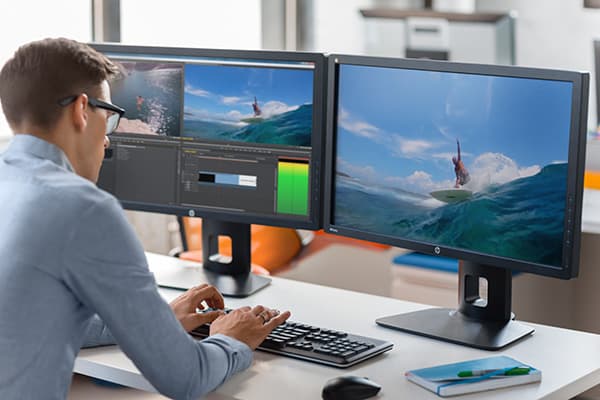Whether it is an office or your home work desk, having multiple monitors is a blessing in today’s time, it makes working easy and also allows you to finish work faster.
However, if you are wondering how multiple monitors work, then this guide is for you. Go through and you’ll learn not only how they work, but how to connect them, why, and how you should use them as well.
How Do Multiple Monitors Work?
Multiple monitors work once you connect them to the CPU or your laptop via VGA, HDMI, or DVI cables. Once you connect the power cord to a power outlet and the cable to the CPU or laptop, windows will automatically discover the new monitor that has been added and will allow you to customize it.
Most office dual monitors come with HDMI cables. And for laptop connection VGA cables are easy to use. That being said, you can easily add one secondary monitor to the laptop since most of the laptops come with one HDMI or VGA port.
But for two or more monitor connections, You will need a suitable laptop for multiple monitors. However, people usually use splitters which allow you to connect multiple monitors.
How to Set Up Multiple Monitors?
Setting up multiple monitors isn’t a tough job at all, follow the below steps and you’ll get it done.
Connect
Plug in the power cable and then whatever cable the monitors came with, plug it in on the CPU. Once they are connected properly, the second monitor and the old monitor will have the same image, now you’ll have to configure them. Below we have mentioned several multiple monitor configurations you can make.
Different Mode Configuration
From the setting option, click on the display, then scroll down, you should find an option called Multiple displays. Click on multiple displays, the drop-down list will have all the following modes.
Pc Screen Only: You’ll find a mode named Pc screen only which means the primary monitor will work only. The secondary one won’t work. The first monitor is called the primary monitor and when you add an extra monitor that’s secondary. You should switch to this mode when you are not needing the secondary monitor or if any particular program isn’t working properly.
Mirror Mode: As the name suggests, in mirror mode the secondary monitor will show the same thing that the primary monitor is showing. People don’t use this mode often unless there is a need for it.
In most computers, when you connect the secondary monitor, by default it stays on the mirror mode. This mode comes into play when you have some people on the opposite side of you and you want to show them exactly what you are doing.
Extend Display: This is the most used mode and it helps a lot with work. In extended display mode the secondary monitor works as an extra display, it gives an extra screen space to do your stuff more efficiently and faster. For example, you are a student and reading something on the screen.
With a single display, you will have to minimize the reading window to take a note in a word file or anything, which is irritating. With an extended display, you can keep the reading tab on one monitor and the note on the other. That will allow you to take notes easily and faster.
Second Screen only: As the name says, this mode turns off the primary display or monitor and allows you to work on the secondary display. Not a popular mode at all but comes in handy when your primary monitor is broken or the display not working properly.
Adjust resolution
When you are adding a new monitor to your computer, there is a high chance that the display sizes won’t be the same and if you don’t customize the resolution, the secondary display might wrap images, and the letters will be blurred, and hard to read.
You can change the resolution from the setting. In windows, click on the left of the mouse and then go to the display option. Then scroll down, right under the scale and layout, and you will find the display resolution. There would be different resolutions, click on each to try and then set one that fits best.
Let me make it simple for you.
- Go to settings and then click on system. Your pc might have different categories, if you don’t find display in the setting, then look for an option named display, it should be there. Click on that.
- Then scroll down and you’ll find the display resolution, some computers might have it as screen resolution or only resolution.
- Then click on the display resolution, you find different resolutions there, choose one that fits perfectly.
Display Arrangement
Once you connect a new monitor, you will have to set on which side the new screen will appear. It will require a few clicks to do that. Do the following.
- Go to settings.
- Click on display.
- You should an option like “rearrange your display”
- Drag display on whatever side you like.
- Then click on apply.
Using Third-Party Tools
You can have a lot of features in modern operating systems for dual monitors. But in case you don’t know, there are some third-party tools as well which bring some advanced dual-monitor features to the table. They make customization super easy.
Conclusion
Multiple monitors are a blessing for someone who is always sorting through sheets, editing images, writing codes, doing math, making notes, and doing research. It not only makes it easy to work but also allows you to do things faster and efficiently.
However, I hope now you know How Multiple Monitors Work. Don’t forget to leave your comment below, if there is anything else I can help you with.



